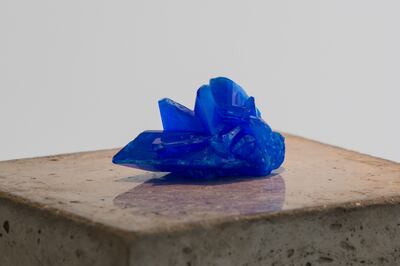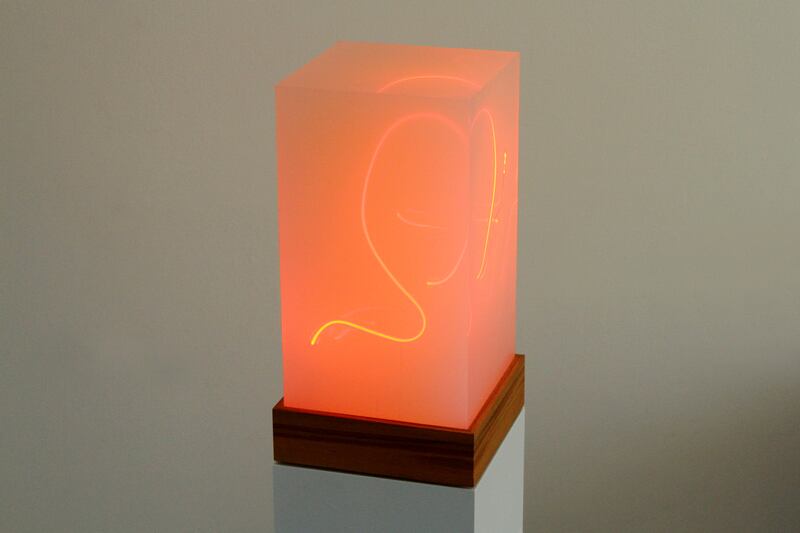For the past few months, Vartan Avakian has been hopscotching around Lebanon to complete his installation A Sign For Things to Come, a neon work that essentially serves as the latest segment in his career trajectory. The piece can be surmised as one body of work divided into a series of installations.
Avakian’s creative focus is anchored in what he refers to as the “materiality of memory” – how materials, visible or not, can be deciphered and what that retrieved data may signify. Avakian describes A Sign For Things to Come as his own “fossilised artefact”. It will debut at the mother of all art fairs, Art Basel, from September 24 to 26, through the Lebanese-Armenian artist’s Beirut gallery, Marfa’.
Avakian’s hopscotching has been largely propelled by Lebanon’s chronic power cuts and fuel shortages, which, among countless other things, has hindered his pace of production. Thankfully, his father managed to secure him a “bag-sized” camping generator that is powered by 20 litres of fuel. This means he can keep a light on and power his phone and laptop, and keep his internet connected.
Among the areas Avakian has been frequenting are his home town, Byblos, where his family still live; his studio in Al Zarif district in Beirut; Marfa’ in the port area, the nearby Arab Image Foundation for which he serves as a board member; and Bourj Hammoud, the Lebanese capital’s Armenian neighbourhood, also one of the region’s most densely populated districts. It is in this area that Avakian worked on the neons for A Sign For Things to Come, something he says “is already a kind of fossil” because it traps neon gas in a tube.
“The thing about neon is that when it’s agitated, it glows. When it’s not agitated, it doesn’t mean there’s no neon in there. It just means it’s dormant. So, just because it doesn’t light up, it doesn’t mean there’s nothing in there.”
The concept of the unknown is the crux of his creative production: here is a material that is present in its invisibility. The artwork’s name, however, does have a rather suggestive and sinister ring to it, as though a warning is delicately laced within. There is some truth to this ominous messaging and Avakian intends for this work to serve as a note of caution, as well as a relic worthy of exploration able to function as a witness to its time.
One facet of A Sign For Things to Come is the language used in the neon signs – Avakian is deeply interested in the tension that languages can cause, citing the unfamiliarity of scripts such as Devanagari and Armenian, the latter found in abundance in Bourj Hammoud. “These signs were perceived as foreign and thus a potential threat to Arabs because they didn’t understand it,” says Avakian. “And the unknown triggers the imagination, and can cause fear.”
Neon, he says, is slowly disappearing from contemporary life and offers an accurate reading of the socio-economic pulse. Avakian’s master’s in Architecture and Urban Culture from the Universitat Politecnica de Catalunya and the Centre de Cultura Contemporania in Barcelona informed his understanding of signage and its symbolism. “Neon was always expensive, a sign of something, and reflective of access to resources,” he explains.
Shops in heavily populated areas such as Bourj Hammoud may advertise their services either handwritten or typed on A4 paper. Vinyl is a next step and neon is the optimum and ultimate statement. “You only invest in neon if your business is doing well and if you’re staying for four to five years,” he says. “With the economic crisis, people didn’t fix their neon signs and reverted to vinyl.”
There are countless ways to preserve stories and keep retelling them. Avakian chose neon for the many tales the gas can tell. “We are obsessed with leaving traces through artefacts or text to tell stories and mark our time,” he says, citing the Pazyryk Carpet, one of the oldest rugs from the fourth to third centuries BC, which he acknowledges is a fine indicator of that era’s carpet-making.
“There are secrets that the weavers didn’t know they were leaving in the carpet, like the analysis of the wool, which could indicate sheep diseases, and DNA study that could explain how and why they used certain dyes.”
His fascination with what unseen materials can tell stems from two very different things: his asthma-induced allergies and a childhood spent in the stunning archaeological wonder that is Byblos, a Unesco World Heritage Site with layers of remains that span centuries and eras.
“There was a sedimentation of histories all around us, so, for example, a neighbour was building their house and while digging up land, found a sarcophagus,” Avakian says.
The dust triggered his asthma, which, in turn, prompted him to wonder: what is dust? “Dust is not a material or element; it is made up of many particles left by humans, animals, fabrics and basically, time,” he explains. “Things are in a state of dust.”

For Marfa’s opening in 2015, Avakian presented Collapsing Clouds of Gas and Dust, a solo exhibition comprising crystals and photographs, which he made by collecting debris from sites including Burj Khalifa in Dubai, Barakat Building in Beirut and the Zamzam Well in Makkah.
“Monuments, like these locations from where I gathered dust, point to the act of remembering and are contingent on the movement of people,” he says. “We shed hair and skin as we go along, and I am proving the monumentality of these places.” In so doing, he creates new memorials.
You may be forgiven for assuming that Avakian’s works, A Sign For Things to Come included, are exhumations. They’re not. They’re merely one man’s guidance on how much evidence can be left.
“Part of what artists can do, aside from creating and generating, is point to traces,” he says. “And that is what I am after. So, rather than create new information, I try to expand the realm of the unknown to trigger imagination.”





